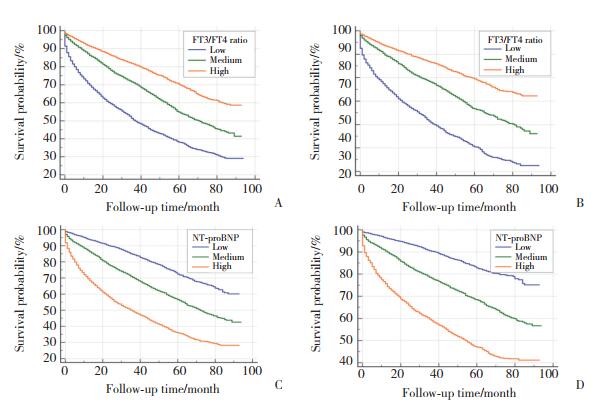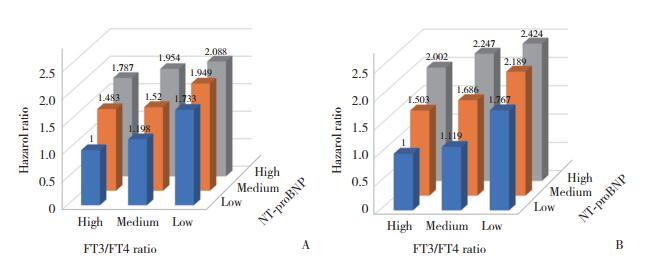文章信息
- 李影, 王传合, 韩苏, 佟菲, 李志超, 孙志军
- LI Ying, WANG Chuanhe, HAN Su, TONG Fei, LI Zhichao, SUN Zhijun
- FT3/FT4比值及联合氨基末端脑钠肽前体对心力衰竭患者预后的评估价值
- The prognostic value of FT3/FT4 ratio and its combination with NT-proBNP in patients with heart failure
- 中国医科大学学报, 2022, 51(4): 313-318
- Journal of China Medical University, 2022, 51(4): 313-318
-
文章历史
- 收稿日期:2021-05-07
- 网络出版时间:2022-04-29 11:21
心力衰竭(简称心衰)是各种心脏病的终末阶段,是肿瘤、重症感染等危重症的严重并发症,具有发病率高、死亡率高的特点。目前,心衰的诊治研究进展缓慢,因此,需要探索更多更好的心衰风险评估及治疗方法。游离三碘甲状腺原氨酸(free triiodothyronine,FT3)和游离甲状腺素(free thyroxine,FT4)是两种主要的甲状腺激素,对心血管系统的生理和病理过程均有影响[1-3]。低T3综合征与心衰患者不良预后有关[4-5],FT3/FT4比值与急性冠脉综合征患者不良预后显著相关[1-2]。FT3/FT4比值对心衰患者预后影响的研究尚未见报道。本研究通过大样本数据分析FT3/FT4比值对心衰患者预后的影响,并进一步联合氨基末端脑钠肽前体(N-terminal brain natriuretic peptide precursor,NT-proBNP)对心衰患者远期预后进行评估,旨在识别出心衰危重患者并积极进行干预,进而改善患者预后。
1 材料与方法 1.1 研究对象收集2013年1月至2018年12月我院心内科住院心衰患者的临床资料。纳入标准:(1)年龄≥18岁。(2)依据指南推荐的典型症状和体征、实验室检查和超声心动图,符合心衰的诊断标准。根据纽约心脏协会(NYHA)心功能分级,心功能分为Ⅱ~Ⅳ级。(3)入院后完善甲状腺功能化验。排除标准:急性心肌梗死、严重肝肾功能不全、严重感染、恶性肿瘤或近期外科手术的患者。研究共收集10 607例心衰患者的临床资料,排除重要数据(FT3、FT4或NT-proBNP)缺失患者(264例)、患有其他严重疾病患者(急性心肌梗死352例、严重肝肾功能不全170例、严重感染80例、恶性肿瘤22例、近期外科手术10例)及失访患者(366例),最终纳入9 343例。本研究获得中国医科大学附属盛京医院伦理委员会批准。
1.2 研究方法采用回顾性队列研究方法,研究者从电子病历中提取相关临床数据,包括一般资料、既往疾病史、化验检查及超声心动图。所有化验检查均为入院当日或次日清晨空腹抽取外周静脉血测定的结果,其中,甲状腺功能应用雅培i2000检测仪、通过化学发光法进行检测。左心室射血分数(left ventricular ejection fraction,LVEF)为入院前3 d内双平面Simpson法测定的超声心动图结果。根据FT3/FT4比值将患者三等分为3组,其中低值组(< 0.217 9)3 114例,中值组(0.217 9~0.274 4)3 115例,高值组(> 0.274 4)3 114例。以全因死亡及心血管死亡为终点事件,所有患者于2020年12月统一进行随访,随访时间平均为3.2年(2~8年)。主要通过辽宁省疾病预防控制中心人口死亡信息登记管理系统、医疗记录、患者的医生或其家属明确患者生存状况及死亡原因,根据国际疾病分类死亡诊断代码确定心源性和非心源性死亡。
1.3 统计学分析应用SAS 9.4软件建立回顾性队列数据库并进行统计分析。正态分布计量资料以x±s表示,组间比较采用独立样本t检验;偏态分布计量资料以M(P25~P75)表示,组间比较采用Kruskal-Wallis H(K)检验;计数资料以率(%)表示,组间比较采用χ2检验。单因素和多因素Cox回归分析影响远期预后的危险因素,并将FT3/FT4比值和NT-proBNP分别三等分,相互组合成9组,比较分析死亡风险比。生存分析采用Kaplan-Meier(KM)法,并使用log-rank检验进行组间比较。受试者操作特征(the receiver operation characteristic,ROC)曲线比较FT3/FT4比值联合NT-proBNP与各独立指标对终点事件的预测价值。所有检验均为双侧,P < 0.05为差异有统计学意义。
2 结果 2.1 3组患者基线资料比较结果显示,患者FT3/FT4比值越低,其年龄越大,心衰越严重,糖尿病、脑卒中比例越高,白细胞、HbA1c、胱抑素C、尿素氮、肌酐、尿酸、血钾、FT4、肌钙蛋白Ⅰ、NT-proBNP等水平也越高,而血红蛋白、白蛋白、总胆固醇、甘油三酯、血钠、FT3、促甲状腺激素等水平越低,见表 1。
| Item | FT3/FT4 1st tertile (n = 3 114) |
FT3/FT4 2nd tertile (n = 3 115) |
FT3/FT4 3rd tertile (n = 3 114) |
P |
| Age(year) | 71.22±13.21 | 69.59±13.21 | 65.88±13.30 | < 0.001 |
| Male [n(%)] | 1 497(48.6) | 1 621(52.5) | 1 858(58.5) | < 0.001 |
| NYHA functional class | < 0.001 | |||
| NYHA classⅡ [n(%)] | 288(9.4) | 647(20.9) | 1 124(35.4) | |
| NYHA class Ⅲ [n(%)] | 1 212(38.4) | 1 374(44.5) | 1 374(43.3) | |
| NYHA class Ⅳ [n(%)] | 1 580(51.3) | 1 068(34.6) | 676(21.3) | |
| CHD [n(%)] | 2 038(66.2) | 2 071(65.4) | 2 075(65.4) | 0.377 |
| Hypertension [n(%)] | 1799(58.4) | 1 996(64.6) | 1 939(61.1) | < 0.001 |
| Diabetes mellitus [n(%)] | 1 098(35.6) | 1 056(34.2) | 931(29.3) | < 0.001 |
| Atrial fibrillation [n(%)] | 887(28.8) | 1 017(32.9) | 1 148(36.2) | < 0.001 |
| Previous MI [n(%)] | 605(19.6) | 567(18.4) | 568(17.9) | 0.186 |
| Stroke [n(%)] | 634(20.6) | 568(18.4) | 529(16.7) | < 0.001 |
| Current smoker [n(%)] | 788(25.6) | 816(26.4) | 984(31.0) | < 0.001 |
| Alcohol-related [n(%)] | 451(14.6) | 524(17.0) | 628(19.8) | < 0.001 |
| WBC(109/L) | 8.26±3.75 | 7.39±2.83 | 7.04±2.30 | < 0.001 |
| Hemoglobin(g/L) | 121.28±24.63 | 127.88±22.02 | 133.89±19.89 | < 0.001 |
| platelet(109/L) | 194.09±79.98 | 191.60±68.90 | 191.49±57.55 | 0.264 |
| albumin(g/L) | 35.28±4.27 | 37.26±4.29 | 39.01±3.88 | < 0.001 |
| TC(mmol/L) | 3.85±1.12 | 4.09±1.10 | 4.30±1.09 | < 0.001 |
| TG(mmol/L) | 1.13±0.78 | 1.30±0.95 | 1.53±1.11 | < 0.001 |
| HbA1c(%) | 6.60±1.46 | 6.54±1.40 | 6.36±1.22 | < 0.001 |
| Cys-C(mg/L) | 1.91±1.06 | 1.61±0.85 | 1.37±0.72 | < 0.001 |
| BUN(mmol/L) | 8.74(6.53-12.56) | 7.25(5.66-9.31) | 6.45(5.22-8.19) | < 0.001 |
| Creatinine(μmol/L) | 93.25(72.30-126.33) | 83.00(67.60-102.51) | 76.25(63.38-93.70) | < 0.001 |
| Uric acid(μmol/L) | 441.8(367.0-570.0) | 441.8(341.0-489.0) | 423.60(333.0-452.4) | < 0.001 |
| Potassium(mmol/L) | 4.12±0.62 | 4.07±0.54 | 4.04±0.45 | < 0.001 |
| Sodium(mmol/L) | 137.63±4.62 | 139.14±3.49 | 139.85±3.01 | < 0.001 |
| FT3(pmol/L) | 2.86±0.64 | 3.59±0.63 | 4.34±1.83 | < 0.001 |
| FT4(pmol/L) | 16.05±3.12 | 14.60±2.49 | 13.38±3.47 | < 0.001 |
| TSH(μIU/mL) | 1.31(0.71-2.22) | 1.53(0.91-2.49) | 1.66(0.97-2.77) | < 0.001 |
| Troponin I(μg/L) | 0.05(0.02-0.27) | 0.03(0.01-0.09) | 0.02(0.00-0.05) | < 0.001 |
| NT-proBNP(pg/mL) | 5 867.3(2 732.8-11 712.0) | 2 968.0(1 271.0-6 025.0) | 1 596.8(647.1-3 499.0) | < 0.001 |
| LVEDV(mL) | 160.82±61.06 | 156.91±60.65 | 157.32±63.32 | 0.024 |
| LVESV(mL) | 90.73±49.70 | 83.75±48.97 | 81.57±51.34 | < 0.001 |
| LVEF(%) | 46.15±12.19 | 49.26±12.02 | 51.07±12.08 | < 0.001 |
| NYHA,New York heart association;CHD,coronary heart disease;MI,myocardial infarction;WBC,white blood cells;TC,total cholesterol;TG,triglycerides;HbA1c,glycosylated hemoglobin,type A1C;Cys-C,cystatin C;BUN,blood urea nitrogen;FT3,free triiodothyronine;FT4,free thyroxine;TSH,thyroid stimulating hormone;NT-proBNP,N-terminal brain natriuretic peptide precursor;LVEDV,left ventricular end diastolic volume;LVESV,left ventricular end systolic volume;LVEF,left ventricular ejection fraction. | ||||
2.2 单因素和多因素Cox回归分析影响远期预后的危险因素
随访期间,共死亡3 915例,其中心血管死亡2 728例。单因素Cox回归分析显示,随着FT3/FT4比值升高,心衰患者的远期全因死亡及心血管死亡风险显著下降,见表 2。多因素Cox回归分析在校正混杂变量后,FT3/FT4比值仍为心衰患者全因死亡及心血管死亡的强预测因子。NT-proBNP也是全因死亡及心血管死亡的强预测因子,见表 2。分别根据FT3/FT4比值及NT-proBNP将患者三等分为3组,KM生存分析显示FT3/FT4比值越低,NT-proBNP越高,全因死亡及心血管死亡累积生存率越低,见图 1。
| Variable | Univariate analysis | Multivariate analysis* | |||
| HR(95%CI) | P | HR(95%CI) | P | ||
| FT3/FT4(per 0.1 increase) | |||||
| Cardiovascular mortality | 0.468(0.439-0.498) | < 0.001 | 0.755(0.662-0.860) | < 0.001 | |
| All-cause mortality | 0.505(0.479-0.532) | < 0.001 | 0.852(0.765-0.948) | 0.003 | |
| NT-proBNP(per 100 pg/mL increase) | |||||
| Cardiovascular mortality | 1.007(1.006-1.007) | < 0.001 | 1.002(1.001-1.003) | < 0.001 | |
| All-cause mortality | 1.006(1.006-1.007) | < 0.001 | 1.002(1.001-1.002) | < 0.001 | |
| * adjusted for age,sex,NYHA functional class,hypertension,diabetes mellitus,atrial fibrillation,stroke,current smoker,alcohol-related,WBC,hemoglobin,albumin,TC,triglycerides,HbA1c,Cys-C,BUN,creatinine,uric acid,potassium,sodium,TSH,troponinⅠ,LVEDV,LVESV,LVEF. | |||||

|
| A, C, all-cause mortality; B, D, cardiovascular mortality. 图 1 KM生存曲线评估心衰患者全因死亡和心血管死亡 Fig.1 KM survival curve for evaluating all-cause and cardiovascular mortality in patients with heart failure |
2.3 FT3/FT4比值联合NT-proBNP评估全因死亡及心血管死亡的价值
在预测心衰患者全因死亡方面,ROC曲线、净重新分类指数(net reclassification index,NRI)、整体鉴别指数(integrated discrimination improvement,IDI)分析结果显示,FT3/FT4比值联合NT-proBNP均显著优于单独应用FT3/FT4比值或NT-proBNP的预测价值。在预测心血管死亡方面,NRI及IDI分析仍提示两者联合显著优于单独应用FT3/FT4比值或NT-proBNP的预测价值。而ROC曲线显示,两者联合仅优于单独应用FT3/FT4比值,而与NT-proBNP比较差异无统计学意义(P > 0.05),见表 3。根据FT3/FT4比值三等分为3组及根据NT-proBNP三等分为3组而相互组合成9组,分析结果显示FT3/FT4比值最低且NT-proBNP最高组全因死亡风险是FT3/FT4比值最高且NT-proBNP最低组的2.088倍,前者心血管死亡风险是后者的2.424倍,见图 2。
| Item | C-statistic | NRI | P1 | IDI | P2 | |
| Z | P | |||||
| All-cause mortality | ||||||
| FT3/FT4+ NT-proBNP vs FT3/FT4 | 13.251 | < 0.001 | 0.426 | < 0.001 | 0.134 | < 0.001 |
| FT3/FT4+ NT-proBNP vs NT-proBNP | 3.259 | 0.001 | 0.426 | 0.020 | 0.153 | 0.020 |
| Cardiovascular mortality | ||||||
| FT3/FT4+ NT-proBNP vs FT3/FT4 | 13.494 | < 0.001 | 0.430 | < 0.001 | 0.163 | < 0.001 |
| FT3/FT4+ NT-proBNP vs NT-proBNP | 0.945 | 0.345 | -0.431 | 0.040 | -0.138 | 0.040 |
| NRI,net reclassification index;IDI,integrated discrimination improvement. | ||||||

|
| A, all-cause mortality; B, cardiovascular mortality. 图 2 根据FT3/FT4比值和NT-proBNP分组评估全因死亡和心血管死亡的相对危险分层 Fig.2 Relative risk stratification for all-cause and cardiovascular mortality assessed by the FT3/FT4 ratio and NT-proBNP tertile grouping |
3 讨论
研究[6-7]显示,心血管系统是甲状腺激素作用的重要靶器官。甲状腺激素异常可影响心血管疾病的临床症状及预后[3-5, 8-9],其浓度的微小变化也会影响心血管的病理生理[3],在已有心衰的患者中这种影响更显著。FT3、FT4是三碘甲状腺原氨酸(triiodothyronine,T3)、甲状腺素(thyroxine,T4)的生理活性形式,比T3和T4更灵敏,更有临床意义[10]。
本研究显示,FT3/FT4比值越低,患者心功能越差,基础状态越差,表现为高龄,糖尿病、脑卒中比例升高等,这些因素可能与心衰患者预后不良有关。多项研究[3, 5, 9]认为FT3降低与心衰发病率和死亡率升高有关,是全因死亡和心血管死亡的预测因子[4]。另有研究[11-12]表明,正常甲状腺功能范围内较高的FT4水平与心衰、心源性猝死之间存在相关性。KANNAN等[9]的研究显示,促甲状腺激素、FT4越高,总三碘甲状腺原氨酸(total triiodothyronine,TT3)越低,患者的心衰程度越重,且左心室辅助装置植入、心脏移植或全因死亡的复合终点风险增加。既往研究[1-2]指出,FT3/FT4比值下降与冠状动脉粥样硬化性心脏病患者远期全因死亡、心源性死亡和主要心血管不良事件风险增加有关。同样,本研究通过Cox回归分析显示,FT3/FT4比值是心衰患者全因死亡及心血管死亡的独立预测因子。FT3/FT4比值每升高0.1,心衰患者的全因死亡风险下降14.8%(HR = 0.852,95%CI:0.765~0.948,P = 0.003),心血管死亡风险下降24.5%(HR = 0.755,95%CI:0.662~0.860,P < 0.001)。
FT3/FT4比值可以反映脱碘酶活性,代表T4向T3的转化[13],FT3/FT4比值下降可能反映了外周T4向T3的转化减少。因此FT3/FT4比值对心衰患者预后影响的可能机制为:(1)FT3转化生成不足,内质网的氧化应激损伤更明显,心肌细胞对于ATP利用障碍,进而影响心肌细胞的收缩功能[14];(2)心肌中存在特定的T3受体,FT3降低可能会使心肌收缩力下降,心律失常易感性增加,并导致心衰患者死亡[5];(3)FT3降低与右心房压力、肺动脉压和肺毛细血管楔压升高以及射血分数和心脏指数降低相关,与心肌纤维化、心室重塑、心肌灌注和代谢异常相关[9]。
NT-proBNP是中国心衰诊断和治疗指南[15]推荐的用于心衰诊断、病情评估及预后评价的生物标志物,NT-proBNP联合循环中miR-133a、血清可溶性生长刺激表达基因2蛋白、心脏超声指标E/e’等可提高NT-proBNP上述作用的准确性[16-18]。本研究证实FT3/FT4比值是心衰患者预后的有效预测因子,然而FT3/FT4比值联合NT-proBNP是否同样能优化NT-proBNP的作用尚无结论,两者联合对心衰患者预后的预测价值是否进一步优于单独应用FT3/FT4比值也是未知,因此,本研究进一步探索了FT3/FT4比值联合NT-proBNP对心衰患者预后的评估价值。结果显示,在预测心衰患者全因死亡方面,ROC曲线、NRI、IDI分析结论一致,均提示FT3/FT4比值联合NT-proBNP显著优于单独应用FT3/FT4比值或NT-proBNP。但在预测心血管死亡方面,ROC曲线的分析结果与NRI及IDI的分析结果出现了分歧,目前尚不清楚原因,未来需要更多的临床随机对照试验明确FT3/FT4比值联合NT-proBNP与单独应用NT-proBNP对预测心血管死亡是否存在差异。
综上所述,FT3/FT4比值降低是心衰患者不良预后的独立预测因子,且FT3/FT4比值联合NT-proBNP显著优于单独应用FT3/FT4比值或NT-proBNP的预测价值。本研究不足之处:(1)虽然样本量很大,但却是单中心、回顾性研究;(2)以往研究[10, 19]表明,碘化造影剂、胺碘酮、糖皮质激素可能会影响甲状腺功能,本研究中未纳入上述药物使用情况分析;(3)只研究了入院时甲状腺功能检测结果,随访期间未监测甲状腺功能变化。
| [1] |
YU TT, TIAN CY, SONG J, et al. Value of the fT3/fT4 ratio and its combination with the GRACE risk score in predicting the prognosis in euthyroid patients with acute myocardial infarction undergoing percutaneous coronary intervention: a prospective cohort study[J]. BMC Cardiovasc Disord, 2018, 18(1): 181. DOI:10.1186/s12872-018-0916-z |
| [2] |
YUAN DS, ZHANG C, JIA SD, et al. Predictive value of free triiodothyronine (FT3) to free thyroxine (FT4) ratio in long-term outcomes of euthyroid patients with three-vessel coronary artery disease[J]. Nutr Metab Cardiovasc Dis, 2021, 31(2): 579-586. DOI:10.1016/j.numecd.2020.10.011 |
| [3] |
RAZVI S, JABBAR A, PINGITORE A, et al. Thyroid hormones and cardiovascular function and diseases[J]. J Am Coll Cardiol, 2018, 71(16): 1781-1796. DOI:10.1016/j.jacc.2018.02.045 |
| [4] |
SATO Y, YOSHIHISA A, KIMISHIMA Y, et al. Low T3 syndrome is associated with high mortality in hospitalized patients with heart failure[J]. J Card Fail, 2019, 25(3): 195-203. DOI:10.1016/j.cardfail.2019.01.007 |
| [5] |
OKAYAMA D, MINAMI Y, KATAOKA S, et al. Thyroid function on admission and outcome in patients hospitalized for acute decompensated heart failure[J]. J Cardiol, 2015, 66(3): 205-211. DOI:10.1016/j.jjcc.2015.04.006 |
| [6] |
GRAIS IM, SOWERS JR. Thyroid and the heart[J]. Am J Med, 2014, 127(8): 691-698. DOI:10.1016/j.amjmed.2014.03.009 |
| [7] |
BRUERE H, FAUCHIER L, BERNARD BRUNET A, et al. History of thyroid disorders in relation to clinical outcomes in atrial fibrillation[J]. Am J Med, 2015, 128(1): 30-37. DOI:10.1016/j.amjmed.2014.07.014 |
| [8] |
NEVES JS, VALE C, VON HAFE M, et al. Thyroid hormones and modulation of diastolic function: a promising target for heart failure with preserved ejection fraction[J]. Ther Adv Endocrinol Metab, 2020, 11: 204201882095833. DOI:10.1177/2042018820958331 |
| [9] |
KANNAN L, SHAW PA, MORLEY MP, et al. Thyroid dysfunction in heart failure and cardiovascular outcomes[J]. Circ Heart Fail, 2018, 11(12): e005266. DOI:10.1161/CIRCHEARTFAILURE.118.005266 |
| [10] |
潘柏申. 甲状腺疾病诊断治疗中实验室检测项目的应用建议[J]. 中华检验医学杂志, 2012, 35(6): 484-492. |
| [11] |
CAPPOLA AR, ARNOLD AM, WULCZYN K, et al. Thyroid function in the euthyroid range and adverse outcomes in older adults[J]. J Clin Endocrinol Metab, 2015, 100(3): 1088-1096. DOI:10.1210/jc.2014-3586 |
| [12] |
CHAKER L, VAN DEN BERG ME, NIEMEIJER MN, et al. Thyroid function and sudden cardiac death: a prospective population-based cohort study[J]. Circulation, 2016, 134(10): 713-722. DOI:10.1161/CIRCULATIONAHA.115.020789 |
| [13] |
MAIA AL, GOEMANN IM, MEYER ELS, et al. Type 1 iodothyronine deiodinase in human physiology and disease[J]. J Endocrinol, 2011, 209(3): 283-297. DOI:10.1530/joe-10-0481 |
| [14] |
颜素岚, 郑昭芬, 练宇, 等. 心力衰竭患者心功能分级、血清N末端脑钠肽前体与甲状腺激素水平的相关性研究[J]. 中华生物医学工程杂志, 2017, 23(1): 19-23. DOI:10.3760/cma.j.issn.1674-1927.2017.01.005 |
| [15] |
中华医学会心血管病学分会心力衰竭学组, 中国医师协会心力衰竭专业委员会, 中华心血管病杂志编辑委员会. 中国心力衰竭诊断和治疗指南2018[J]. 中华心血管病杂志, 2018, 46(10): 760-789. DOI:10.3760/cma.j.issn.0253-3758.2018.10.004 |
| [16] |
GUO MZ, LUO J, ZHAO JL, et al. Combined use of circulating miR-133a and NT-proBNP improves heart failure diagnostic accuracy in elderly patients[J]. Med Sci Monit, 2018, 24: 8840-8848. DOI:10.12659/MSM.911632 |
| [17] |
BAI J, HAN LN, LIU HB. Combined use of high-sensitivity ST2 and NT-proBNP for predicting major adverse cardiovascular events in coronary heart failure[J]. Ann Palliat Med, 2020, 9(4): 1976-1989. DOI:10.21037/apm-20-1046 |
| [18] |
BLANCO R, AMBROSIO G, BELZITI C, et al. Prognostic value of NT-proBNP, and echocardiographic indices of diastolic function, in hospitalized patients with acute heart failure and preserved left ventricular ejection fraction[J]. Int J Cardiol, 2020, 317: 111-120. DOI:10.1016/j.ijcard.2020.04.044 |
| [19] |
VAN DER MOLEN AJ, THOMSEN HS, MORCOS SK, et al. Effect of iodinated contrast media on thyroid function in adults[J]. Eur Radiol, 2004, 14(5): 902-907. DOI:10.1007/s00330-004-2238-z |
 2022, Vol. 51
2022, Vol. 51




